The fitness industry is rife with technology trends that have recently transformed the industry. One of the most significant digital fitness trends worldwide is the rise of fitness apps. A fitness app is an application related to health or fitness that users can download on smart devices, such as laptops, phones, and tablets. It may be accessible on the Android and iPhone operating systems. Fitness apps use artificial intelligence, machine learning, and other technologies to give users customised workout plans.
Fitness users see tremendous value in online training because it is entertaining, provides many new opportunities and workouts, and allows them to share their experiences or compete with other app users.
Another reason for the rapid adoption of these fitness apps, which give users instructions on exercise routines, diet and nutritional programs, physical activity tracking, and other fitness and well-being-related topics, is convenience.
Apart from that, these apps provide access to real-time data, which allows users to track progress over time. Most apps provide users with an opportunity to win new training milestones. They can be used with other devices, such as a heart monitor, to offer workouts and levels and motivate users to perform just like a trainer or coach would in a live class.
Get regular insights
Keep up to date with the latest insights from our research as well as all our company news in our free monthly newsletter.

The global fitness app market was valued at USD 1.21 billion in 2021 and is projected to reach USD 5.41 billion by 2030, registering a CAGR of 18.1 percent from 2022 to 2030.
According to the online public health resource, more than 97,000 fitness and health apps are on tablets and mobile devices (Health Works Collective). Additionally, roughly 15 percent of smartphone users between 18 and 29 have installed health apps, and approximately 52 percent access health-related information through their devices.
According to a survey of users in the United States conducted during the third quarter of 2022, awareness of mobile fitness tracking apps reached 86 percent of respondents in the last measured quarter. Also, 34 percent of respondents actively used apps in this category.
Despite the many benefits and the convenience of working from anywhere, not everyone will transition entirely to online training. Current trends show that most people are looking for a hybrid approach and will take a class or go to the gym while also working out using a fitness app.
Let’s examine the Sweat fitness app case study to understand what drives the fitness app market.
Case Study: Sweat
From personal trainer to managing the biggest fitness community in the world, Sweat is a fitness app that built a community to succeed in the highly competitive fitness app market.
The Big Idea behind Sweat
Kayla Itsines, an Australian personal trainer, started a fitness business at 18 from her home in Adelaide. She soon discovered the mobile device as the perfect tool to help her clients achieve their fitness goals. She joined hands with two other personal trainers and launched Sweat: Kayla Itsines Fitness app. This resulted in a complete fitness program, the Bikini Body Guide, with two options for home and gym.
The program SELF-Post: Pregnancy with Kelsey Wells focused on new mothers and Yoga lessons with Sjana Elise Earp for a healthy body and mind. In this manner, Kayla ensured users wouldn’t sway toward other apps if Sweat could become their go-to for total body and mind well-being.
Let’s look closely at the main strategies used to acquire valuable users and turn the app into a multi-million dollar brand.
The idea behind the app was not how you look but how you feel. The app was built on a “try-before-buy” concept. Like many other apps, the app offers users a free trial for a week. At the end of the seven-day trial period, users must subscribe and pay a monthly fee of $19.99. Therefore, if they see results in the first seven days and feel it is a worthwhile investment, it is easy to hook them in with the free trial period.
The app is hyper-focused on its target audience, primarily women —the branding, content, and style are all targeted toward women.
Sharing results with before and after pictures
The app uses before and after pictures to demonstrate its effectiveness. This is what helped grow subscribers and kept bringing them back. As Kayla shared her clients’ results, she managed to retain and grow her subscriber base. By adding the other two programs to the app with Elise and Kelsey, she ensured they stayed consistent with other apps.
Becoming an Influencer
From not knowing much about the social media landscape to make the list of most appreciated fitness trainers on Forbes, Kayla leveraged her following to grow the app organically. Her YouTube channel has a sleuth of videos that women can follow worldwide, and she currently has 412,000 subscribers. She leveraged social media to grow her subscriber base by using organic techniques to acquire new users.
Building a community
Kayla tapped into the power of community to reach millions of women worldwide.
Since its inception, the Sweat app has been downloaded more than 30 million times. In 2020, the app generated USD 99.5 million in revenue. Sweat’s success lies in its community-first approach, as users share before and after pictures and success stories. This, in turn, keeps other users motivated as they can see the results and believe that it can happen to them, too, if they stick with the program.
In 2021, Kayla sold Sweat, their popular workout platform, to fitness-tech company iFit for a reported USD400 million.
By increasing engagement, fitness apps have proved to be an excellent solution for users worldwide. These apps are also perfect for studio owners looking to supplement their regular brick-and-mortar service.
Technology is progressively making a place for itself in fitness routines and monitoring and treating many chronic diseases.
How do you ensure your brand has its finger on the pulse of this dynamic market and constantly changing consumer preferences?
Download our full report, “Feeling Good: Powering the Next Generation of Fitness and Medtech,” report and find out how brands like Peloton, ŌURA, Noom, Headspace, and others are navigating a fiercely competitive market.


 Senior Marketing Executive
Senior Marketing Executive Sales & Marketing
Sales & Marketing General Manager PR -Internal Communications & Government Affairs
General Manager PR -Internal Communications & Government Affairs Vital Strategies
Vital Strategies
 Customer Intelligence Director
Customer Intelligence Director